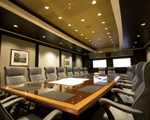Conference room acoustics are often overlooked in the design process, but they can quickly become a problem (and a high priority) once the room is put into use. Architects are great at designing aesthetically pleasing boardrooms and conference rooms, and when their clients see the renderings, acoustics is normally the furthest thing from their mind. Thus, the acoustical design of the boardroom goes unaddressed. But when the client moves in and has trouble holding meetings, acoustics comes to the forefront.
There are three basic types of acoustical issues that should be addressed when designing a conference room or boardroom:
- Sound isolation to avoid noise disturbance and to achieve good speech privacy.
- Room finishes to create an acoustical environment conducive to discussion over the length of long boardroom tables.
- HVAC system noise control to reduce background noise and further provide for discussions over those long tables.
Sound isolation means exactly what the term implies – that the room needs to be acoustically isolated from outside noise, and that it needs to stop private conversations from being heard outside the room. It involves specifying wall types with an appropriate Sound Transmission Class (STC), ensuring that glazing will not degrade the wall composite STC, and using doors with acoustical seals. Often, it’s the little details that degrade the sound isolation, such as boardroom walls that do not extend from slab to slab, frameless interior wall glazing, doors without acoustical seals, and common return air ducts.
The next challenge is that boardroom tables often place people 20 or more feet apart, making it difficult to carry on a conversation. Communication is further compromised if the boardroom is excessively reverberant, impacting not only communication within the room but also the sound quality at the other end of a teleconference or video conference. The solution is to use wall and ceiling finishes that naturally amplify sound within the boardroom while at the same time reducing reverberation. An acoustical consultant can help provide the right balance of absorption, reflection, and diffusion, creating an environment of clear communication and free flowing discussion.
Finally, the HVAC noise level needs to be controlled. When the air conditioning system kicks on during the heat of summer, you can count on it “masking” or “covering” a significant amount of the oral communication. We have even heard of companies turning the HVAC off during meetings because of the noise. And of course, in the summer and winter months, that can make a long meeting nearly unbearable.
But if you design it right, a good boardroom will be free of noise disturbance from the exterior and from adjacent interior spaces. Employees outside of the boardroom will not be able to understand conversations taking place in the boardroom, and board members will be able to easily communicate with people at the other end of the table or on the other end of a teleconference or video conference. All of this can be achieved if the architect includes acoustics as an important design parameter.
